International Business Basics and Bangladesh: Lecture 01 Analysis
VerifiedAdded on 2022/09/26
|17
|1057
|31
Homework Assignment
AI Summary
This assignment provides a comprehensive overview of international business fundamentals, focusing on the differences between international and domestic business operations. It delves into the impact of globalization, examining factors driving its growth and the debates surrounding it. The document explores various entry modes for international markets, including considerations for market selection, timing, and scale. It also covers key international trade theories, such as mercantilism, absolute and comparative advantage, and others, along with arguments supporting companies' engagement in international business. The content includes an analysis of challenges and opportunities for Bangladesh in international business, referencing various sources like Hill and Daniels' texts. The assignment also provides resources for further research on trade data and market access.
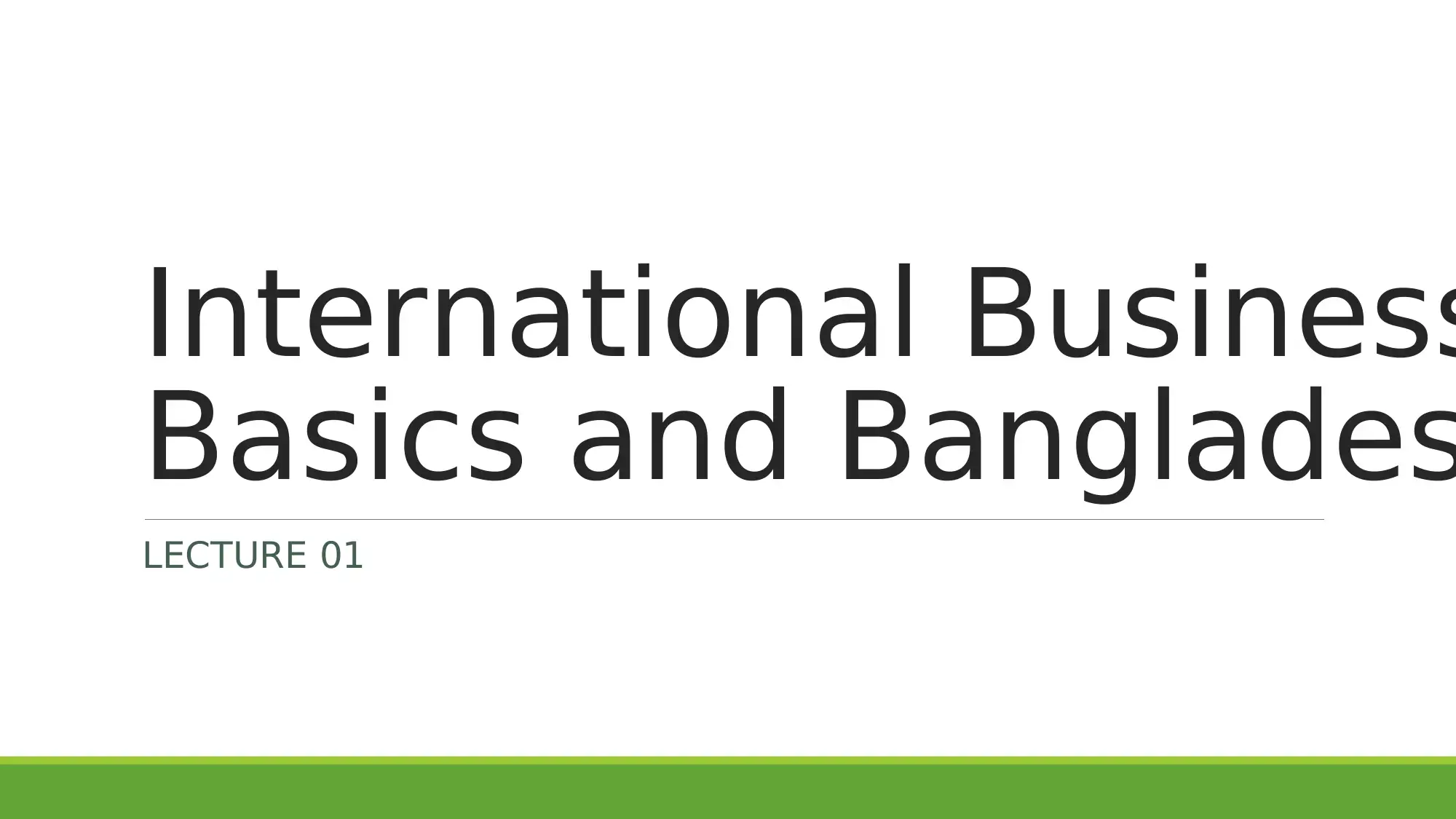
International Business
Basics and Banglades
LECTURE 01
Basics and Banglades
LECTURE 01
Paraphrase This Document
Need a fresh take? Get an instant paraphrase of this document with our AI Paraphraser
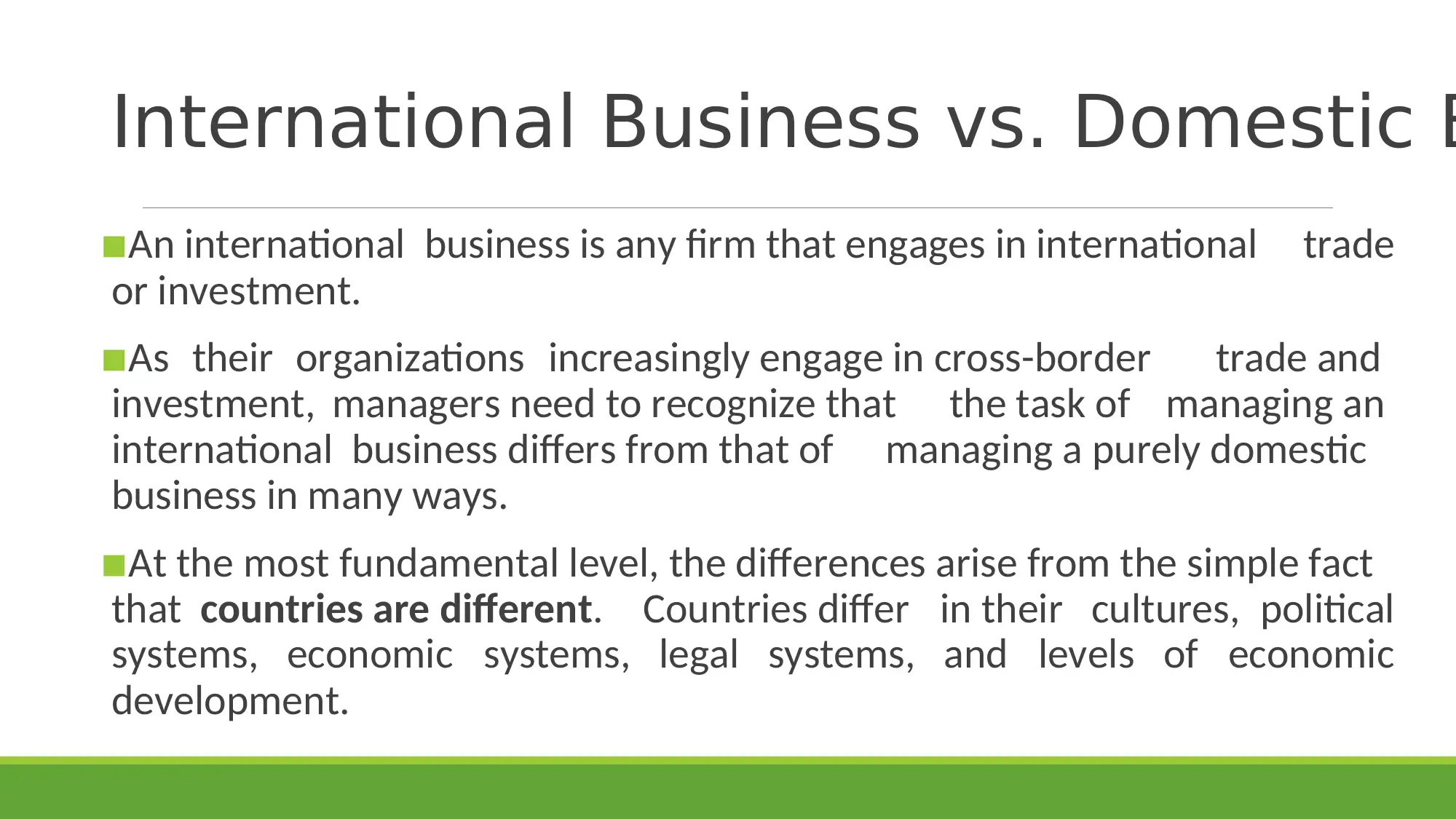
International Business vs. Domestic B
▪An international business is any firm that engages in international trade
or investment.
▪As their organizations increasingly engage in cross-border trade and
investment, managers need to recognize that the task of managing an
international business differs from that of managing a purely domestic
business in many ways.
▪At the most fundamental level, the differences arise from the simple fact
that countries are different. Countries differ in their cultures, political
systems, economic systems, legal systems, and levels of economic
development.
▪An international business is any firm that engages in international trade
or investment.
▪As their organizations increasingly engage in cross-border trade and
investment, managers need to recognize that the task of managing an
international business differs from that of managing a purely domestic
business in many ways.
▪At the most fundamental level, the differences arise from the simple fact
that countries are different. Countries differ in their cultures, political
systems, economic systems, legal systems, and levels of economic
development.
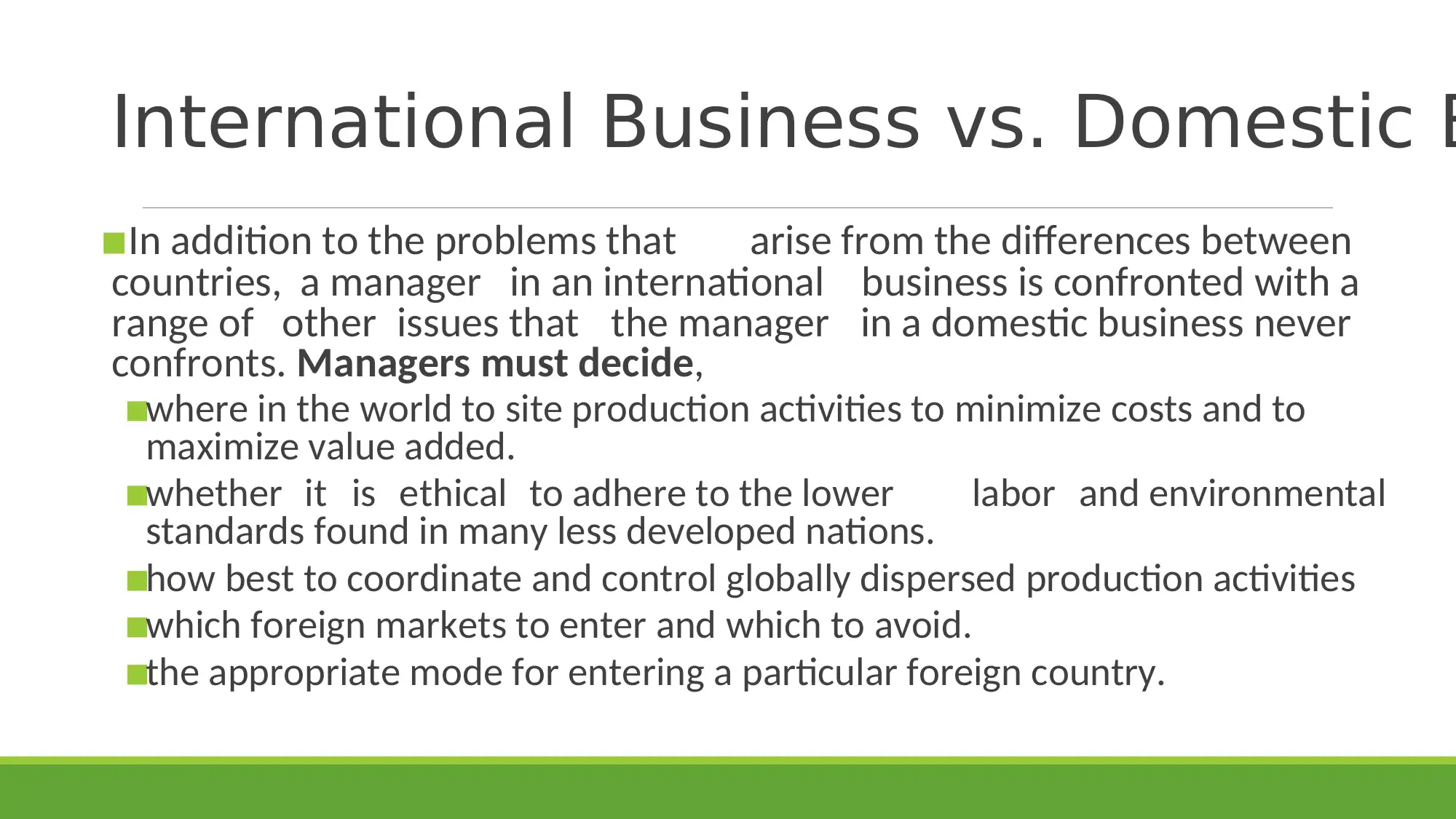
International Business vs. Domestic B
▪In addition to the problems that arise from the differences between
countries, a manager in an international business is confronted with a
range of other issues that the manager in a domestic business never
confronts. Managers must decide,
▪where in the world to site production activities to minimize costs and to
maximize value added.
▪whether it is ethical to adhere to the lower labor and environmental
standards found in many less developed nations.
▪how best to coordinate and control globally dispersed production activities
▪which foreign markets to enter and which to avoid.
▪the appropriate mode for entering a particular foreign country.
▪In addition to the problems that arise from the differences between
countries, a manager in an international business is confronted with a
range of other issues that the manager in a domestic business never
confronts. Managers must decide,
▪where in the world to site production activities to minimize costs and to
maximize value added.
▪whether it is ethical to adhere to the lower labor and environmental
standards found in many less developed nations.
▪how best to coordinate and control globally dispersed production activities
▪which foreign markets to enter and which to avoid.
▪the appropriate mode for entering a particular foreign country.
⊘ This is a preview!⊘
Do you want full access?
Subscribe today to unlock all pages.

Trusted by 1+ million students worldwide
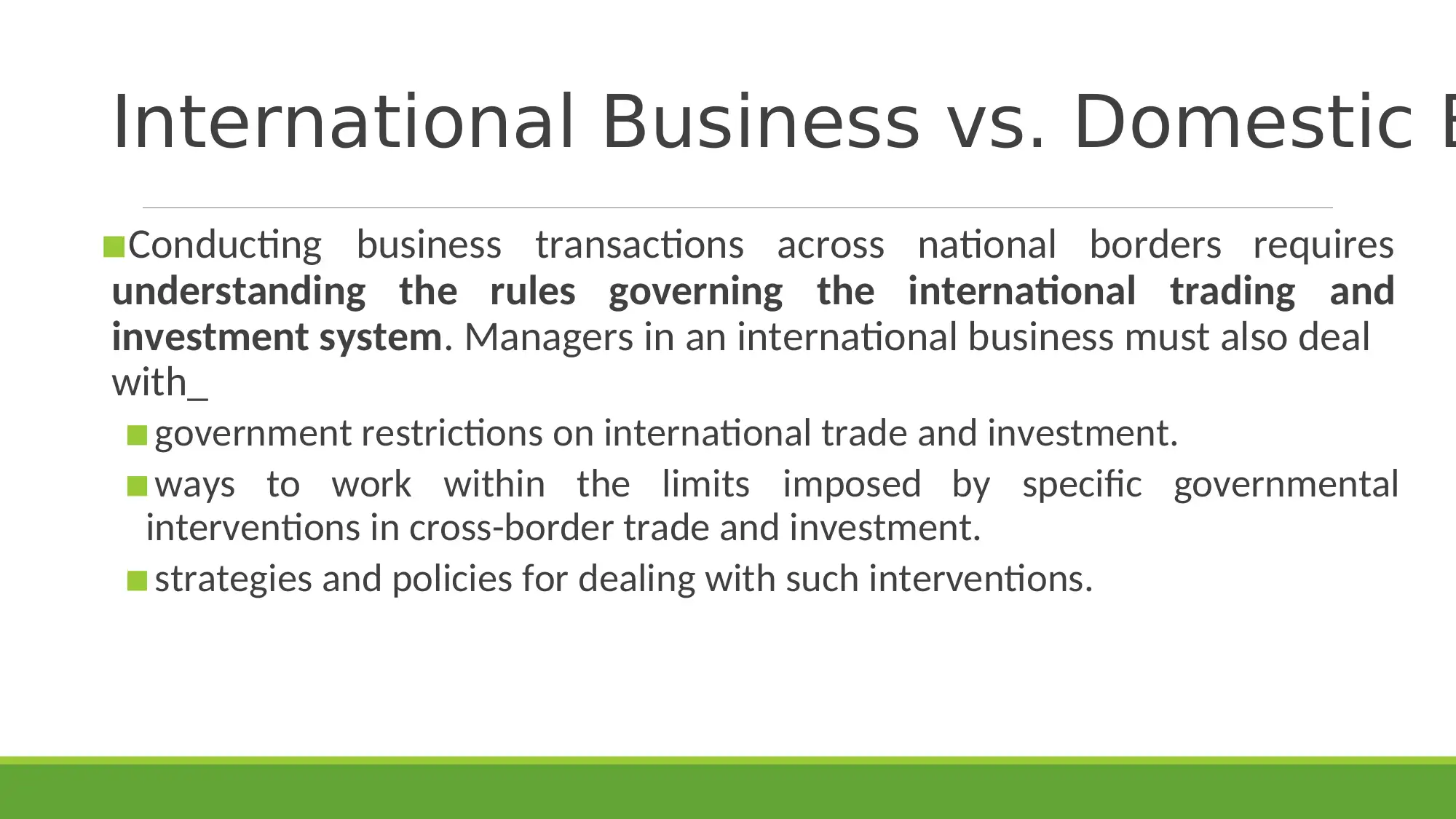
International Business vs. Domestic B
▪Conducting business transactions across national borders requires
understanding the rules governing the international trading and
investment system. Managers in an international business must also deal
with_
▪government restrictions on international trade and investment.
▪ways to work within the limits imposed by specific governmental
interventions in cross-border trade and investment.
▪strategies and policies for dealing with such interventions.
▪Conducting business transactions across national borders requires
understanding the rules governing the international trading and
investment system. Managers in an international business must also deal
with_
▪government restrictions on international trade and investment.
▪ways to work within the limits imposed by specific governmental
interventions in cross-border trade and investment.
▪strategies and policies for dealing with such interventions.
Paraphrase This Document
Need a fresh take? Get an instant paraphrase of this document with our AI Paraphraser
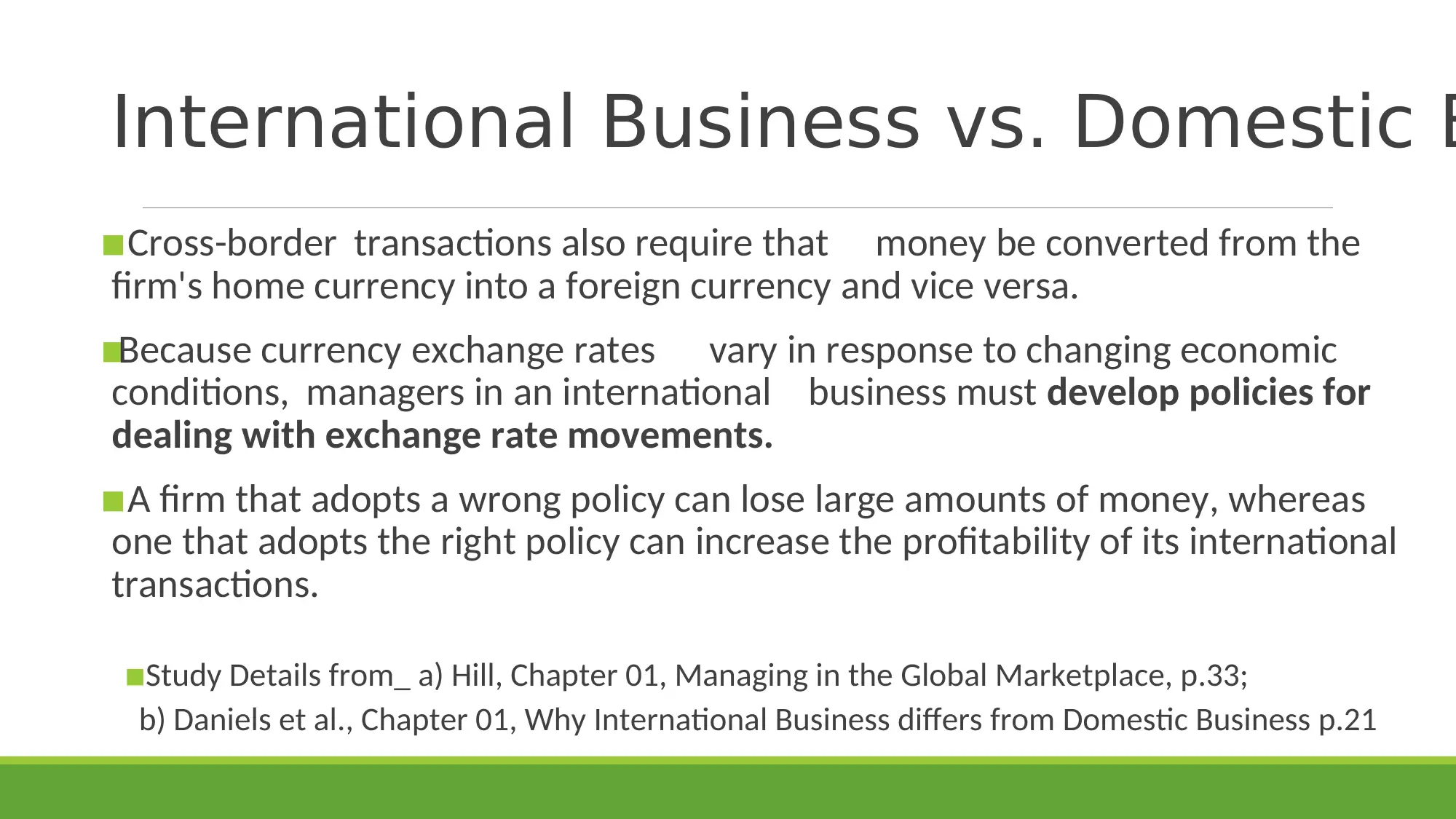
International Business vs. Domestic B
▪Cross-border transactions also require that money be converted from the
firm's home currency into a foreign currency and vice versa.
▪Because currency exchange rates vary in response to changing economic
conditions, managers in an international business must develop policies for
dealing with exchange rate movements.
▪A firm that adopts a wrong policy can lose large amounts of money, whereas
one that adopts the right policy can increase the profitability of its international
transactions.
▪Study Details from_ a) Hill, Chapter 01, Managing in the Global Marketplace, p.33;
b) Daniels et al., Chapter 01, Why International Business differs from Domestic Business p.21
▪Cross-border transactions also require that money be converted from the
firm's home currency into a foreign currency and vice versa.
▪Because currency exchange rates vary in response to changing economic
conditions, managers in an international business must develop policies for
dealing with exchange rate movements.
▪A firm that adopts a wrong policy can lose large amounts of money, whereas
one that adopts the right policy can increase the profitability of its international
transactions.
▪Study Details from_ a) Hill, Chapter 01, Managing in the Global Marketplace, p.33;
b) Daniels et al., Chapter 01, Why International Business differs from Domestic Business p.21
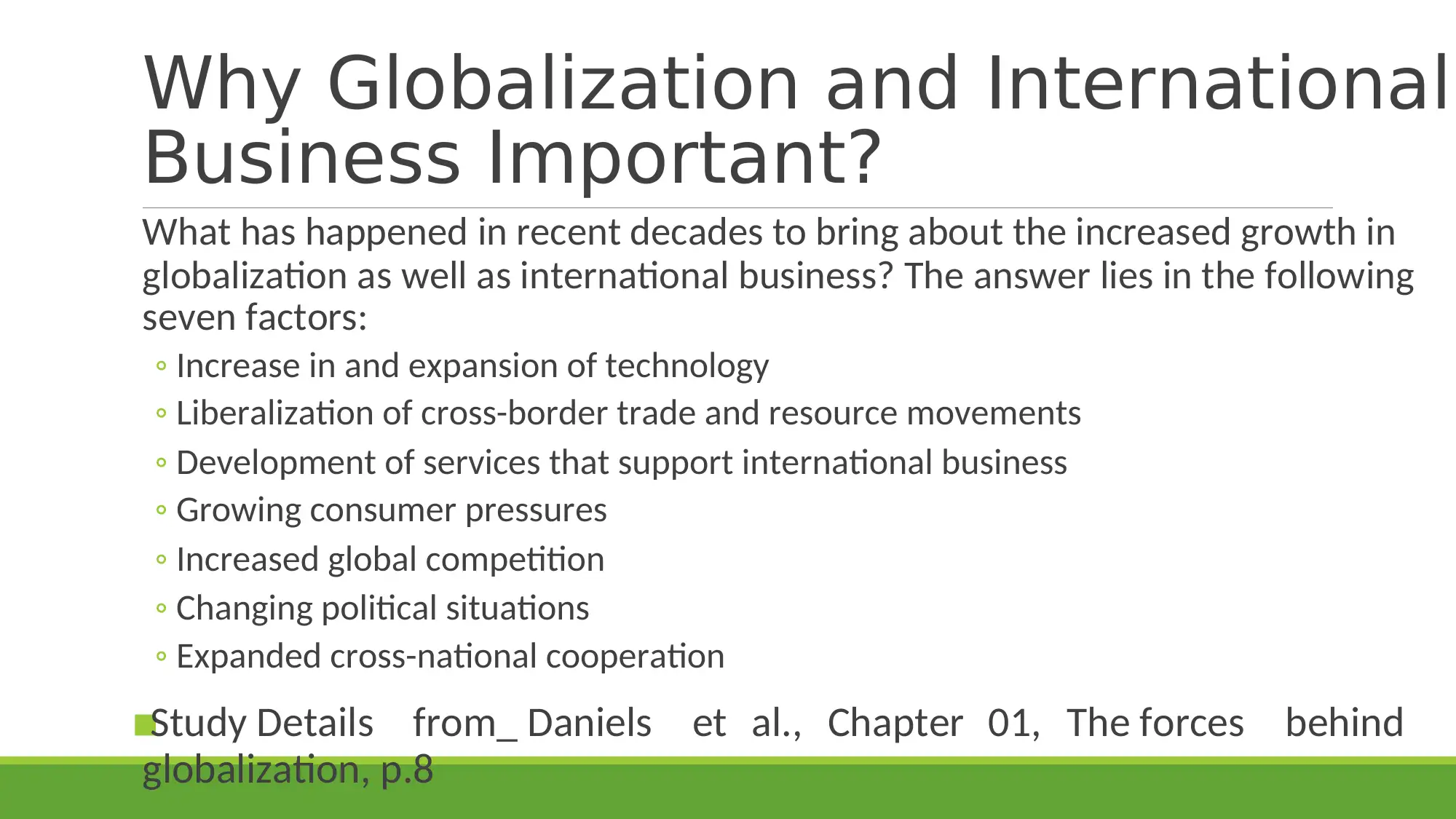
Why Globalization and International
Business Important?
What has happened in recent decades to bring about the increased growth in
globalization as well as international business? The answer lies in the following
seven factors:
◦ Increase in and expansion of technology
◦ Liberalization of cross-border trade and resource movements
◦ Development of services that support international business
◦ Growing consumer pressures
◦ Increased global competition
◦ Changing political situations
◦ Expanded cross-national cooperation
▪Study Details from_ Daniels et al., Chapter 01, The forces behind
globalization, p.8
Business Important?
What has happened in recent decades to bring about the increased growth in
globalization as well as international business? The answer lies in the following
seven factors:
◦ Increase in and expansion of technology
◦ Liberalization of cross-border trade and resource movements
◦ Development of services that support international business
◦ Growing consumer pressures
◦ Increased global competition
◦ Changing political situations
◦ Expanded cross-national cooperation
▪Study Details from_ Daniels et al., Chapter 01, The forces behind
globalization, p.8
⊘ This is a preview!⊘
Do you want full access?
Subscribe today to unlock all pages.

Trusted by 1+ million students worldwide
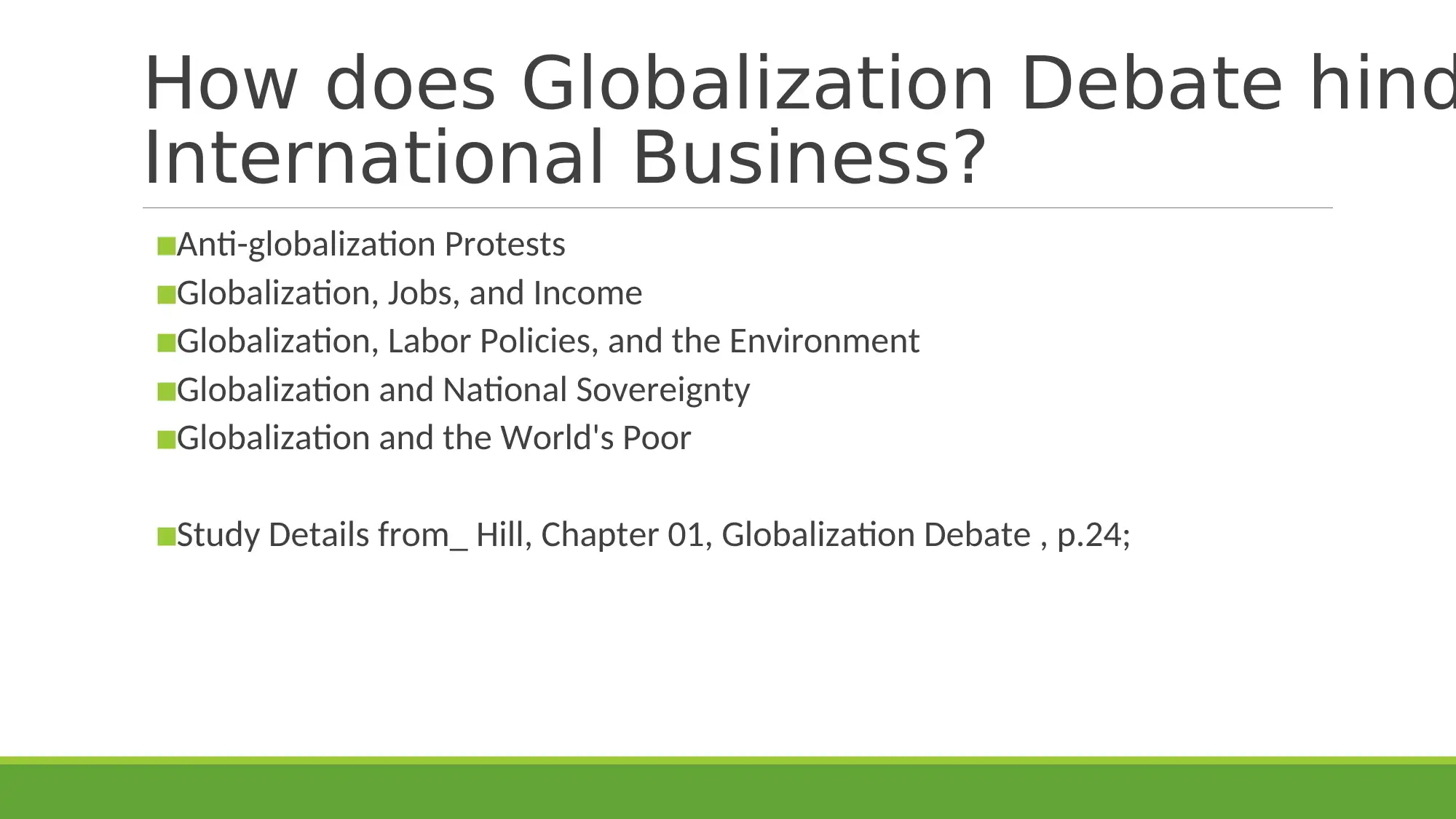
How does Globalization Debate hind
International Business?
▪Anti-globalization Protests
▪Globalization, Jobs, and Income
▪Globalization, Labor Policies, and the Environment
▪Globalization and National Sovereignty
▪Globalization and the World's Poor
▪Study Details from_ Hill, Chapter 01, Globalization Debate , p.24;
International Business?
▪Anti-globalization Protests
▪Globalization, Jobs, and Income
▪Globalization, Labor Policies, and the Environment
▪Globalization and National Sovereignty
▪Globalization and the World's Poor
▪Study Details from_ Hill, Chapter 01, Globalization Debate , p.24;
Paraphrase This Document
Need a fresh take? Get an instant paraphrase of this document with our AI Paraphraser
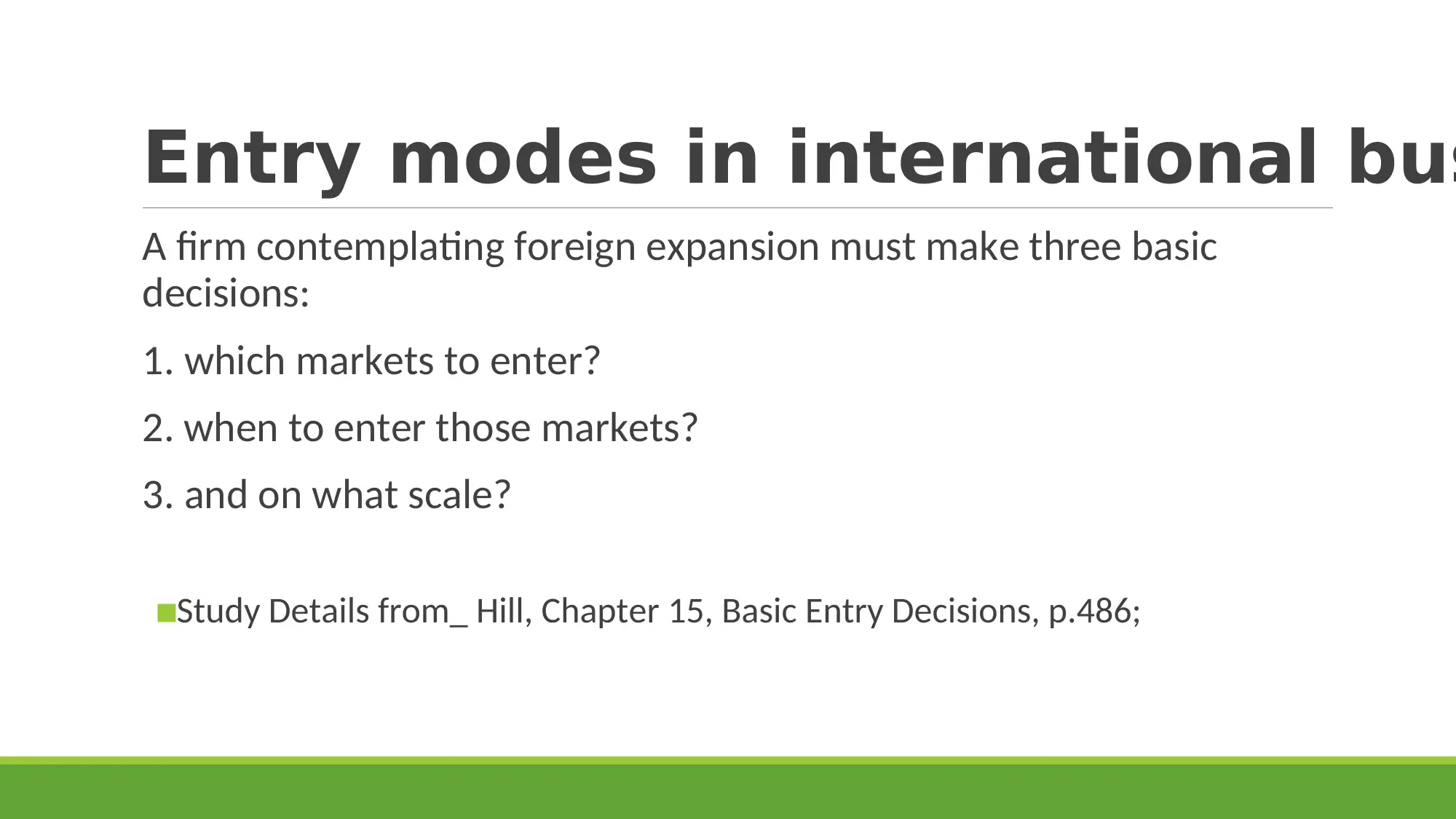
Entry modes in international bus
A firm contemplating foreign expansion must make three basic
decisions:
1. which markets to enter?
2. when to enter those markets?
3. and on what scale?
▪Study Details from_ Hill, Chapter 15, Basic Entry Decisions, p.486;
A firm contemplating foreign expansion must make three basic
decisions:
1. which markets to enter?
2. when to enter those markets?
3. and on what scale?
▪Study Details from_ Hill, Chapter 15, Basic Entry Decisions, p.486;
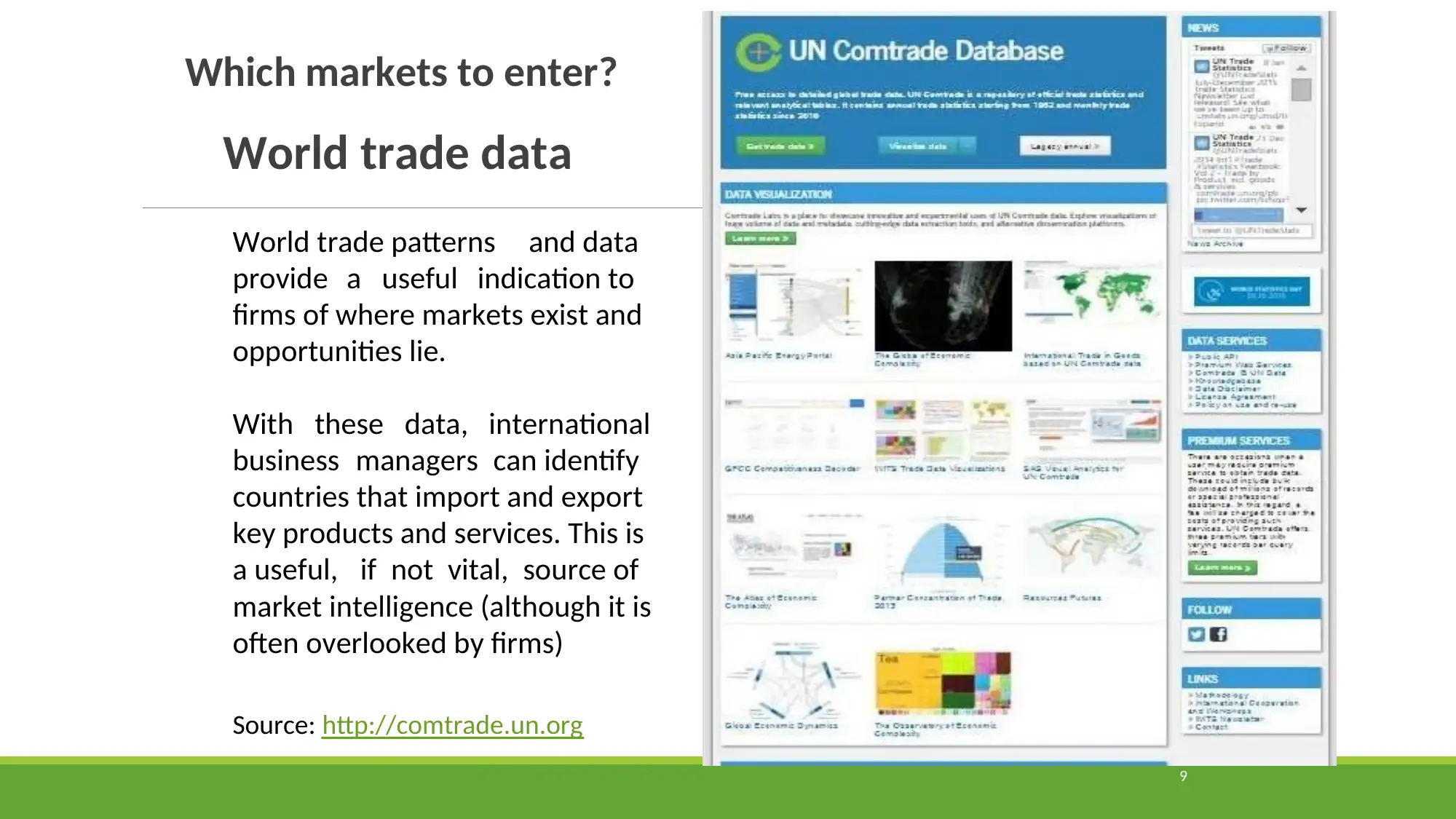
World trade data
Source: http://comtrade.un.org
World trade patterns and data
provide a useful indication to
firms of where markets exist and
opportunities lie.
With these data, international
business managers can identify
countries that import and export
key products and services. This is
a useful, if not vital, source of
market intelligence (although it is
often overlooked by firms)
9
Which markets to enter?
Source: http://comtrade.un.org
World trade patterns and data
provide a useful indication to
firms of where markets exist and
opportunities lie.
With these data, international
business managers can identify
countries that import and export
key products and services. This is
a useful, if not vital, source of
market intelligence (although it is
often overlooked by firms)
9
Which markets to enter?
⊘ This is a preview!⊘
Do you want full access?
Subscribe today to unlock all pages.

Trusted by 1+ million students worldwide
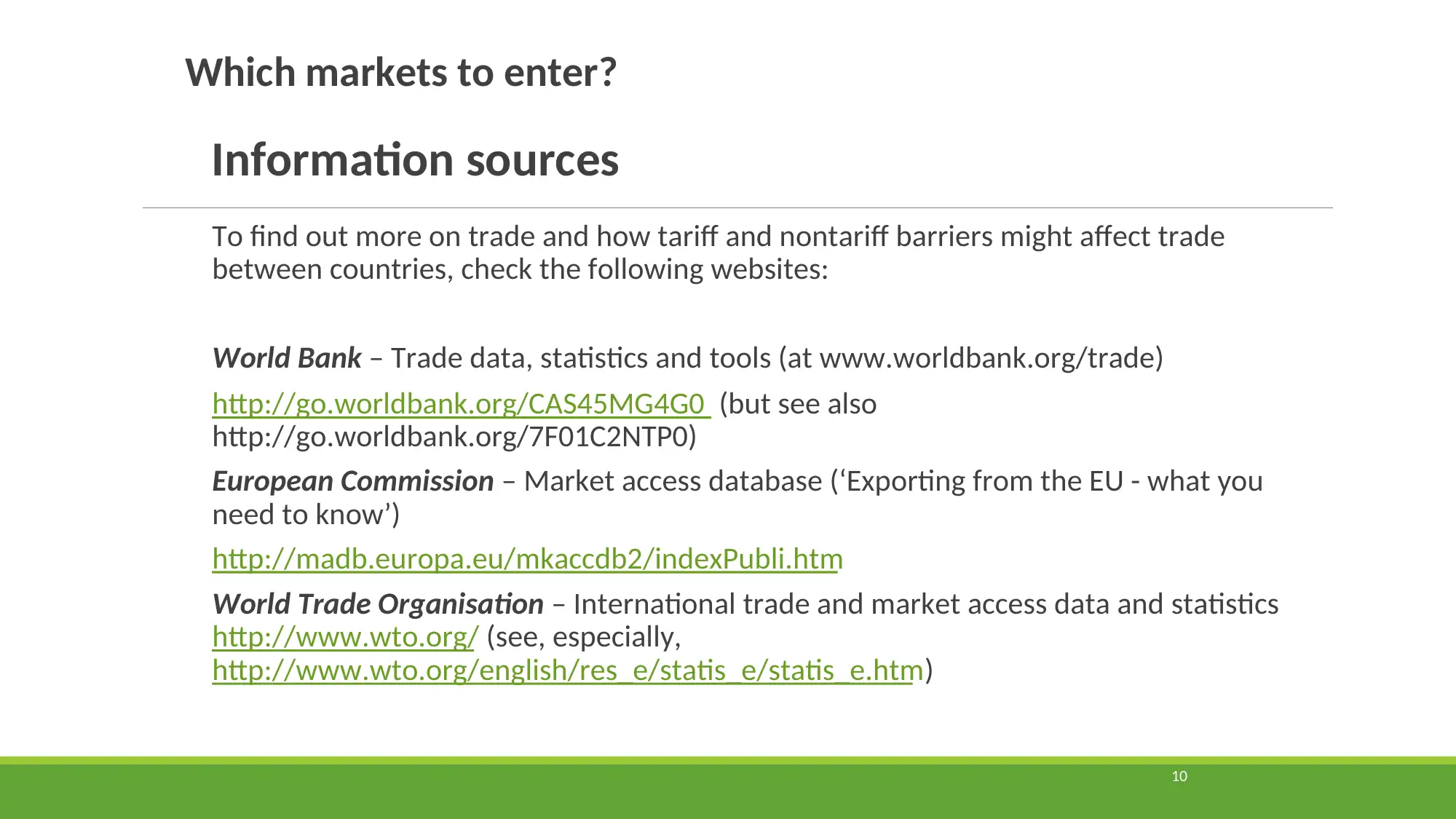
Information sources
To find out more on trade and how tariff and nontariff barriers might affect trade
between countries, check the following websites:
World Bank – Trade data, statistics and tools (at www.worldbank.org/trade)
http://go.worldbank.org/CAS45MG4G0 (but see also
http://go.worldbank.org/7F01C2NTP0)
European Commission – Market access database (‘Exporting from the EU - what you
need to know’)
http://madb.europa.eu/mkaccdb2/indexPubli.htm
World Trade Organisation – International trade and market access data and statistics
http://www.wto.org/ (see, especially,
http://www.wto.org/english/res_e/statis_e/statis_e.htm)
10
Which markets to enter?
To find out more on trade and how tariff and nontariff barriers might affect trade
between countries, check the following websites:
World Bank – Trade data, statistics and tools (at www.worldbank.org/trade)
http://go.worldbank.org/CAS45MG4G0 (but see also
http://go.worldbank.org/7F01C2NTP0)
European Commission – Market access database (‘Exporting from the EU - what you
need to know’)
http://madb.europa.eu/mkaccdb2/indexPubli.htm
World Trade Organisation – International trade and market access data and statistics
http://www.wto.org/ (see, especially,
http://www.wto.org/english/res_e/statis_e/statis_e.htm)
10
Which markets to enter?
Paraphrase This Document
Need a fresh take? Get an instant paraphrase of this document with our AI Paraphraser
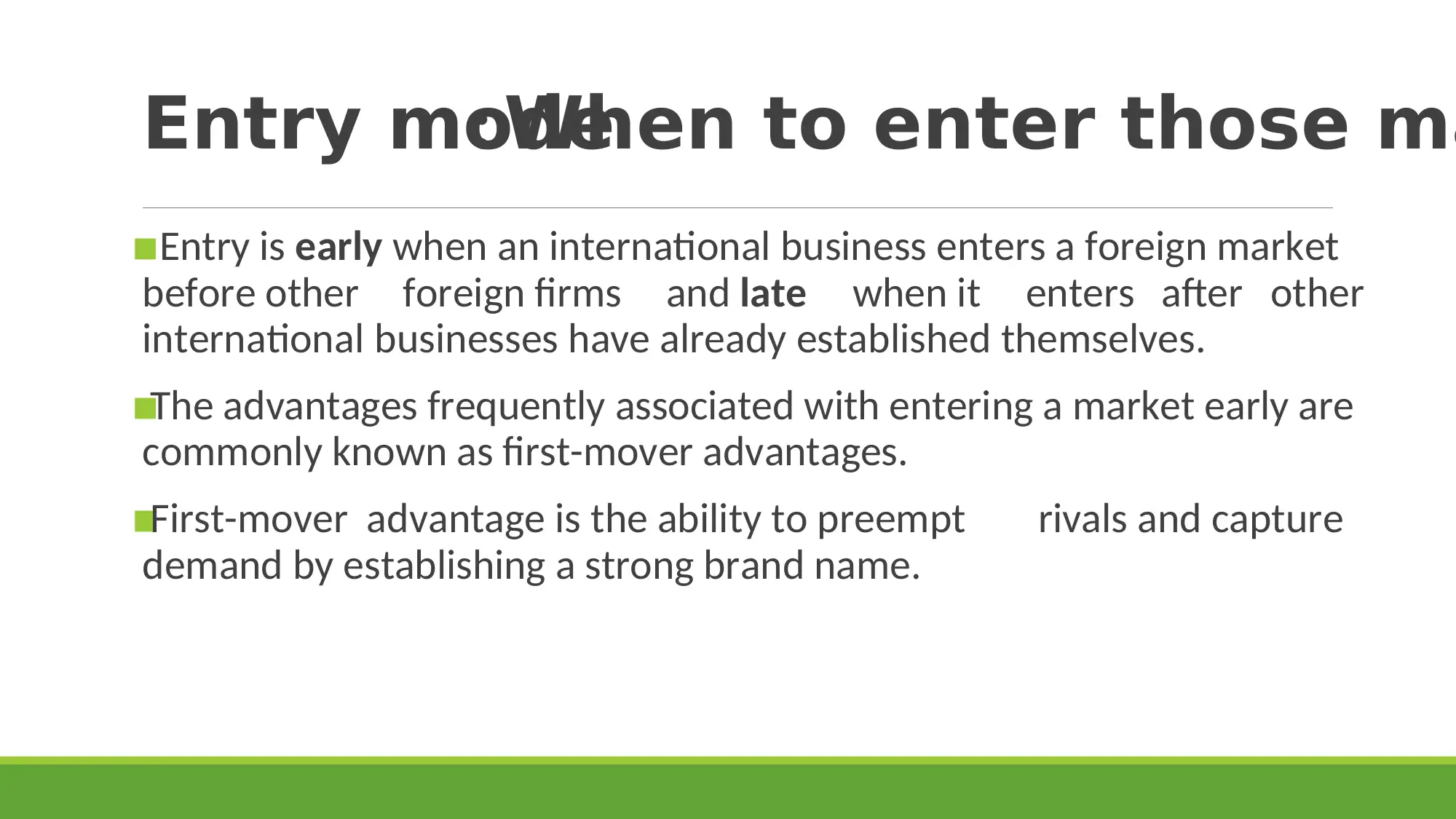
Entry mode: When to enter those ma
▪Entry is early when an international business enters a foreign market
before other foreign firms and late when it enters after other
international businesses have already established themselves.
▪The advantages frequently associated with entering a market early are
commonly known as first-mover advantages.
▪First-mover advantage is the ability to preempt rivals and capture
demand by establishing a strong brand name.
▪Entry is early when an international business enters a foreign market
before other foreign firms and late when it enters after other
international businesses have already established themselves.
▪The advantages frequently associated with entering a market early are
commonly known as first-mover advantages.
▪First-mover advantage is the ability to preempt rivals and capture
demand by establishing a strong brand name.
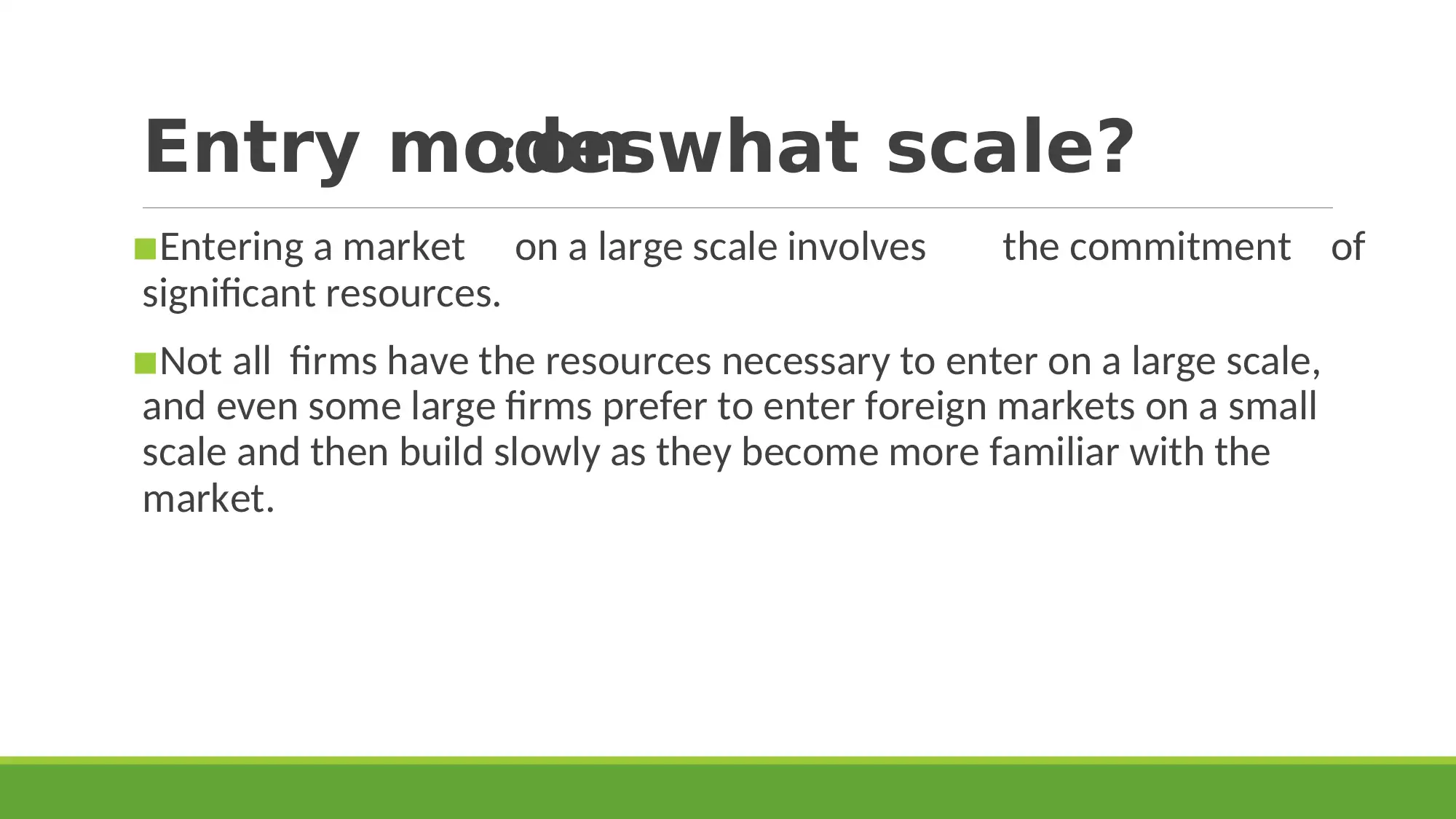
Entry modes: on what scale?
▪Entering a market on a large scale involves the commitment of
significant resources.
▪Not all firms have the resources necessary to enter on a large scale,
and even some large firms prefer to enter foreign markets on a small
scale and then build slowly as they become more familiar with the
market.
▪Entering a market on a large scale involves the commitment of
significant resources.
▪Not all firms have the resources necessary to enter on a large scale,
and even some large firms prefer to enter foreign markets on a small
scale and then build slowly as they become more familiar with the
market.
⊘ This is a preview!⊘
Do you want full access?
Subscribe today to unlock all pages.

Trusted by 1+ million students worldwide
1 out of 17
Related Documents
Your All-in-One AI-Powered Toolkit for Academic Success.
+13062052269
info@desklib.com
Available 24*7 on WhatsApp / Email
![[object Object]](/_next/static/media/star-bottom.7253800d.svg)
Unlock your academic potential
Copyright © 2020–2025 A2Z Services. All Rights Reserved. Developed and managed by ZUCOL.





